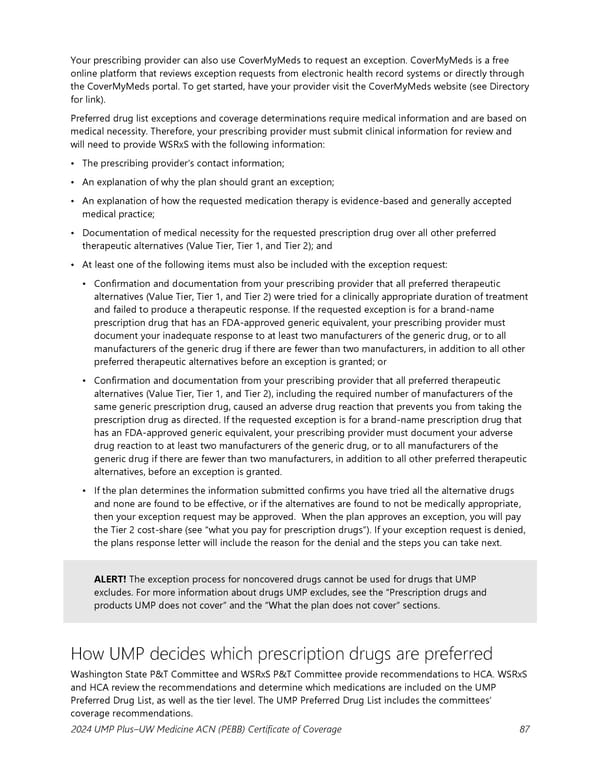Your prescribing provider can also use CoverMyMeds to request an exception. CoverMyMeds is a free online platform that reviews exception requests from electronic health record systems or directly through the CoverMyMeds portal. To get started, have your provider visit the CoverMyMeds website (see Directory for link). Preferred drug list exceptions and coverage determinations require medical information and are based on medical necessity. Therefore, your prescribing provider must submit clinical information for review and will need to provide WSRxS with the following information: • The prescribing provider’s contact information; • An explanation of why the plan should grant an exception; • An explanation of how the requested medication therapy is evidence-based and generally accepted medical practice; • Documentation of medical necessity for the requested prescription drug over all other preferred therapeutic alternatives (Value Tier, Tier 1, and Tier 2); and • At least one of the following items must also be included with the exception request: ▪ Confirmation and documentation from your prescribing provider that all preferred therapeutic alternatives (Value Tier, Tier 1, and Tier 2) were tried for a clinically appropriate duration of treatment and failed to produce a therapeutic response. If the requested exception is for a brand-name prescription drug that has an FDA-approved generic equivalent, your prescribing provider must document your inadequate response to at least two manufacturers of the generic drug, or to all manufacturers of the generic drug if there are fewer than two manufacturers, in addition to all other preferred therapeutic alternatives before an exception is granted; or ▪ Confirmation and documentation from your prescribing provider that all preferred therapeutic alternatives (Value Tier, Tier 1, and Tier 2), including the required number of manufacturers of the same generic prescription drug, caused an adverse drug reaction that prevents you from taking the prescription drug as directed. If the requested exception is for a brand-name prescription drug that has an FDA-approved generic equivalent, your prescribing provider must document your adverse drug reaction to at least two manufacturers of the generic drug, or to all manufacturers of the generic drug if there are fewer than two manufacturers, in addition to all other preferred therapeutic alternatives, before an exception is granted. ▪ If the plan determines the information submitted confirms you have tried all the alternative drugs and none are found to be effective, or if the alternatives are found to not be medically appropriate, then your exception request may be approved. When the plan approves an exception, you will pay the Tier 2 cost-share (see “what you pay for prescription drugs”). If your exception request is denied, the plans response letter will include the reason for the denial and the steps you can take next. ALERT! The exception process for noncovered drugs cannot be used for drugs that UMP excludes. For more information about drugs UMP excludes, see the “Prescription drugs and products UMP does not cover” and the “What the plan does not cover” sections. How UMP decides which prescription drugs are preferred Washington State P&T Committee and WSRxS P&T Committee provide recommendations to HCA. WSRxS and HCA review the recommendations and determine which medications are included on the UMP Preferred Drug List, as well as the tier level. The UMP Preferred Drug List includes the committees’ coverage recommendations. 2024 UMP Plus–UW Medicine ACN (PEBB) Certificate of Coverage 87
 UMP Plus–UW Medicine Accountable Care Network (UW Medicine ACN) COC (2024) Page 87 Page 89
UMP Plus–UW Medicine Accountable Care Network (UW Medicine ACN) COC (2024) Page 87 Page 89